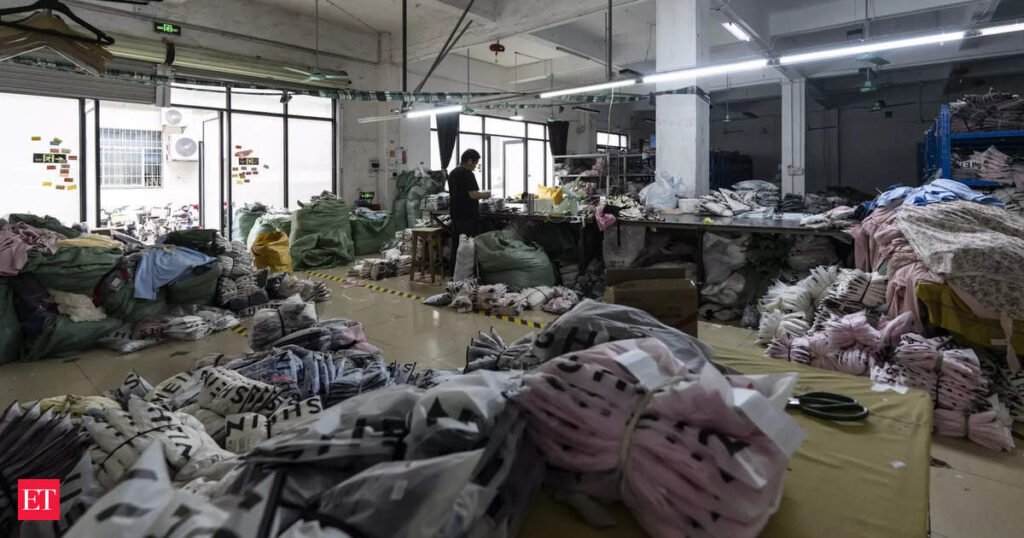US and China headed for ‘monumental’ break up, placing world economic system on edge

The brinkmanship displayed by the 2 nations has already far exceeded the battles they waged throughout President Donald Trump‘s first time period. In 2018 and 2019, Trump raised tariffs on China over 14 months. The most recent escalation has performed out largely over a matter of days, with levies which might be far better and apply to broader swath of products.
On Wednesday, Trump countered China’s resolution to match his 50% levy — a penalty for Beijing’s countermeasure to an earlier U.S. tariff — with a further responsibility, elevating the speed on Chinese language imports to 125%.
As laborious as Trump has pushed, China has refused to again down. China has elevated its tariffs on items imported from the U.S. to 84%. It pledged once more Thursday to “combat to the tip,” an method that’s in line with how Xi Jinping, the nation’s prime chief, has sought to redefine the worldwide order — one with Beijing, not Washington, on the middle.
“We’re approaching a monumental prepare wreck breakup,” mentioned Orville Schell, the Arthur Ross director of the Middle on U.S.-China Relations at Asia Society in New York. “The material that we so rigorously had woven collectively during the last a number of a long time is ripping aside.”
In danger is a relationship that formed the worldwide economic system within the twenty first century. For years, each side benefited. American corporations’ intensive use of China’s factories saved costs in verify for American customers and padded the income of the nation’s largest corporations. China obtained jobs and funding that lifted hundreds of thousands of Chinese language households out of poverty. And as China’s spending energy grew, it opened up an enormous and profitable marketplace for American manufacturers. That association has been examined by China’s emergence as a worldwide energy, and a rising U.S. concern that it had grow to be susceptible to strain by China over entry to elements and supplies essential to superior expertise and manufacturing. It isn’t clear who will blink first, or if the 2 sides can discover frequent floor. One factor is for certain: The looming disruption to the move of billions of {dollars} price of products between China and the USA, in addition to the commerce that usually passes by way of different nations, can have a devastating affect on each economies and their buying and selling companions.
“You may’t mannequin this,” mentioned Steven Okun, CEO of APAC Advisors, a geopolitical consulting agency. “Are nations going to have to decide on between the U.S. and China?”
Economists are predicting that the divide might drive the U.S. economic system into recession. On the similar time, the Chinese language economic system is dealing with the prospect of a painful divorce from its largest buying and selling accomplice, which buys greater than $400 billion price of products annually, because the nation is reeling from a property market collapse and sluggish client confidence.
Since the USA and China are central to the worldwide economic system, the affect will reverberate in every single place. Their sparring comes as Trump has additionally imposed a base tariff of 10% on most U.S. buying and selling companions and levies on foreign-made vehicles and imported metal and aluminum — impediments to commerce which were virtually forgotten within the tariff whiplash of current days.
Beijing was caught off guard by Trump altering the principles of worldwide commerce in his first time period. It matched U.S. tariffs with its personal tariffs on imports from the USA. However Beijing shortly ran out of American items to penalize, as a result of China purchased so little from the USA. The 2 nations reached a truce in January 2020, an settlement that was considered in Beijing as unfavorable to the Chinese language facet.
On the marketing campaign path final yr, Trump appeared prepared to go even additional. He spoke of imposing tariffs of 60% on Chinese language imports. Most economists and buyers disregarded the stump speech as hyperbole — a marketing campaign promise that will get whittled down within the face of financial realities.
Nevertheless it offered China with ample warning to plan countermeasures that might inflict most financial ache on the USA. To this point, Beijing has responded to Trump with excessive tariffs in addition to menacing reminders that it might choke off the availability of essential minerals.
The potential for the battle to push the 2 nations additional aside is larger than ever.
Dan Wang, a director on Eurasia Group’s China group, mentioned some Chinese language corporations are already trying past the USA. For instance, China plans to export 6 million electrical autos this yr, virtually none to the USA. She mentioned that whereas there’s a probability of a worldwide recession, the chance is larger in America.
Three months in the past, the Worldwide Financial Fund provided its financial forecast for the approaching yr: The U.S. economic system was in higher form than simply about all others.
Now, many forecasters see the potential of a U.S. recession. After Trump imposed stinging tariffs on almost each nation, analysts are predicting increased inflation, extra unemployment and slower development in the USA.
“I imagine {that a} recession has already began and the economic system goes to deteriorate remarkably within the second quarter,” Carl Weinberg, chief economist at Excessive Frequency Economics, mentioned earlier than Trump reversed himself on a number of the non-China tariffs.
The impact of the tariffs might be felt throughout the U.S. economic system. Wendong Zhang, an assistant professor of utilized economics and coverage at Cornell College, mentioned 73% of smartphones, 78% of laptops, 87% of online game consoles and 77% of toys in the USA come from China.
China, for its half, remains to be digging out of a property disaster that has touched its total economic system. Native governments are struggling to lift sufficient cash to pay for entitlement packages, whereas monetary establishments are saddled with debt. Unemployment is excessive, and younger individuals are struggling to search out promising jobs.
On Thursday, Goldman Sachs downgraded expectations for the Chinese language economic system, although it’s anticipating an enormous quantity of stimulus spending by Beijing. It lowered its development outlook for this yr to 4%, from 4.5% — excessive development by American requirements however a sluggish tempo for China.
China has relied on an outpouring of products from Chinese language factories to offset weak point in the remainder of its economic system. However the U.S. tariffs will sap demand and China’s different buying and selling companions, already cautious a couple of deluge of Chinese language items, is likely to be reluctant to choose up the slack.
For small companies in each China and the USA, the sudden rupture within the buying and selling partnership is devastating. It presents an existential risk for John Ok. Thomas, whose enterprise in California making digital thermometers for animals is determined by shopping for electrical elements made in China and promoting the completed items to Chinese language dairy farms.
“For China to grow to be my second-biggest buyer base has been essential for our enterprise to proceed within the final 15 years,” mentioned Thomas of his firm, GLA Agricultural Electronics, which was based in 1969.
The previous three days have been a curler coaster for Thomas as the 2 nations pushed one another to the brink. On Sunday, he raced to get models shipped to his largest buyer in China earlier than a spherical of 34% tariffs on American items would take impact.
After Trump introduced extra tariffs, the Chinese language buyer requested for extra, anticipating a response from Beijing. Thomas scrambled to drag collectively extra of the product, however China beat him to the punch and mentioned it had raised tariff charges once more to 84%, successfully ending any probability at holding the shopper for now.
“We have been near being priced out of the Chinese language market,” he mentioned. “At 84%, we’re utterly shut out.”
This text initially appeared in The New York Occasions.








